Law enforcement in Australia
Law enforcement in Australia is one of the three major components of the country's justice system, along with courts and corrections. Law enforcement officers are employed by all three levels of government – federal, state/territory, and local.
.jpg.webp)
Federally, the main law enforcement agency is the Australian Federal Police (AFP), which has a wide mandate to enforce Australian criminal law and protect its national interests. There is also a number of other agencies that have powers confined to specific areas, such as national security (ASIO), customs and immigration (ABF), and white-collar crime (ATO, ACCC, ASIC). Each branch of the Australian Defence Force (ADF) has its own military police, although there is also an overarching ADF Investigative Service for more complex investigations.
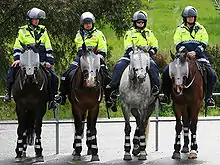
As each Australian state enacts its laws, general law enforcement duties are the responsibility of state police forces, who are in turn responsible to a government minister (usually the Minister for Police). These forces carry out the bulk of general policing throughout the entire state. Other State-government departments may also have investigative powers for specific offences within their purview. The Northern Territory also has its police force, but in Australia's other territories (including the Australian Capital Territory) law enforcement is handled by the Federal Government.
Australian state and federal police routinely carry firearms. While on duty, most officers' duty belts consist of a handgun, Taser, expandable baton, pepper spray, a set of handcuffs, ammunition magazines, gloves, torch, and a two-way radio. Local governments have their own smaller force of authorised officers – known as council rangers – to enforce local laws pertaining solely to individual local government jurisdictions. Council rangers generally do not have full police powers (unless they are sworn as special constables).
Federal
Australian Federal Police
The primary federal law enforcement agency in Australia is the Australian Federal Police. The AFP is responsible for the investigation of federal offences (crimes against the Commonwealth) and has federal jurisdiction throughout Australia. It provides protective services to federal government property and personnel/dignitaries, including major airports, buildings, foreign embassies/diplomats and provides state-styled law enforcement services to external territories, the Australian Capital Territory and the Jervis Bay Territory. The boundaries between the two levels of law enforcement are somewhat flexible and both state and federal police cooperate on or transfer cases between each other depending on the specific circumstances.
The AFP also provides liaison officers to various overseas posts to assist in relations with various police forces overseas, as well as providing community policing to assist in the development of foreign law enforcement agencies and peacekeeping operations in locations such as the Solomon Islands with the RAMSI Mission and Cyprus.
The AFP was created in 1979, having been the result of an amalgamation of the now-defunct Commonwealth Police and Australian Capital Territory Police Force. This makes it quite young as many of the various state police forces were established in the 19th century.
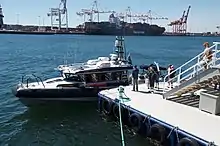
Australian Border Force
The Australian Border Force is responsible for customs and immigration enforcement and border protection at Australia's ports as well as in Australian waters, and conducts investigations where the AFP does not have primary jurisdiction. Unlike AFP Officers, Border Force Officers do not have fully vested federal police powers and can only exercise arrest and detain powers at Airport jurisdictions. They may however, detain persons for state or federal crimes or warrants until that person can be presented to a federal or state law enforcement officer with the appropriate powers. Australian Border Force officers have the authority to carry firearms when a supervisor approves. In practice, only maritime, specialist counter-terrorism officers and Investigators carry firearms.
Military
Military Police, also known as Service Police, are the law enforcement branches of the services of a military tasked with enforcing and investigating offences violating military law. In Australia, each service of the Australian Defence Force maintains its independent police force made up of military personnel from that service. Along with the independent service police forces is the Australian Defence Force Investigative Service, a special ADF unit made up of Investigators from each service's police and tasked with investigating more serious military offences.
Australian Army Military Police
Law enforcement duties in the Australian Army are provided by the Royal Australian Corps of Military Police. MPs provide everything from general law enforcement duties on military installations to investigations, close personal protection and more.
National common policing services
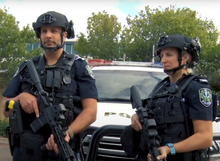
The Australia New Zealand Policing Advisory Agency (ANZPAA) was established in October 2007.[1] ANZPAA is a joint initiative of the Australian and New Zealand Police Commissioners and is funded by contributions to Australia and New Zealand Police jurisdictions. ANZPAA is a non-operational policing agency that provides strategy and policy advice, and secretarial services to the ANZPAA Board on cross-jurisdictional policing initiatives that help enhance community safety and security. ANZPAA's strategic direction is set by ANZPAA’s board and the Australia New Zealand Council of Police Professionalisation (ANZCoPP, formerly Australasian Police Professional Standards Committee, APPSC).
The Australasian Police Professional Standards Committee (APPSC) was an organisation that served all police jurisdictions around Australia and New Zealand. It was the body for police education and training in Australia and New Zealand; the council comprising each of the police commissioners from Australia and New Zealand along with the president of the Police Federation of Australia and the president of the New Zealand Police Association. On 9 November 2007, APPSC roles and functions were amalgamated into ANZPAA. In 2013, APPSC was retitled to the Australia New Zealand Council of Police Professionalisation.
Crime Stoppers programs run in each state and nationally. Crime Stoppers programs collect information about crimes and pass it on to the police, ensuring that the community can participate in fighting crime.
CrimTrac is an intergovernmental policing agency that supports Australian policing through the provision of forensic and other information, and investigative tools between state and federal police departments. The National Automated Fingerprint Identification System (NAFIS) is a national fingerprint database, administered by CrimTrac.[2]
State
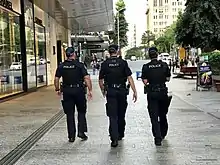
Each state, as well as the Northern Territory, is responsible for maintaining its police force which is responsible for policing at the state and local levels. This involves general law and order, forensics, traffic policing, major crime, anti-terrorism branches, water police, search and rescue and in some states transit police. Local policing in the Australian Capital Territory, Jervis Bay Territory and Australia's external territories is contracted to the Australian Federal Police (AFP).
In some states, local governments employ by-laws officers or rangers to enforce local by-laws or ordinances relating to such matters as parking, dog ownership, retailing, littering, or water usage. These local government officers are not considered to be police forces as they generally only have the power to issue fines and do not have the same powers as state police. They may rely upon appointment as a special constable or legislated powers for their authority.
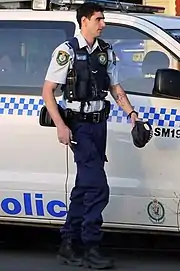
Policing agencies
State police also perform certain functions on behalf of the Australian government such as the enforcement of various Commonwealth Acts and regulations in conjunction with the Australian Federal Police and other Commonwealth officers.
While ACT policing is under the jurisdiction of the Australian Federal Police, the following policing agencies are regulated by their respective state or territory government and are highly visible:
Sheriffs
In recent years, the states and territories have returned the responsibility of recovering court-ordered fines to their sheriffs. In practice, the police often carry out the functions of sheriffs and bailiffs in rural and more sparsely populated areas of Australia.
The office of sheriff was first established in Australia in 1824. This was simultaneous with the appointment of the first Chief Justice of New South Wales. The role of the sheriff has not been static, nor is it identical in each Australian state. In the past a sheriff's duties included: executing court judgments, acting as a coroner, the transportation of prisoners, managing the jails, and carrying out executions (through the employment of an anonymous hangman).
Currently, no Australian state provides for capital punishment. A government department (usually called the Department of Corrections or similar) now runs the prison system and the coroner's office handles coronal matters. The sheriff is now largely responsible for enforcing the civil orders and fines of the court by seizing and selling the property of judgment debtors who do not satisfy the debt, providing court security, enforcing arrest warrants, evictions, taking juveniles into custody and running the jury system.[3] Some state sheriffs can also apply a wide range of sanctions ranging from suspending driver's licenses and car registration through to wheel clamping and arranging community service orders, and as a last resort can make arrests.
Local
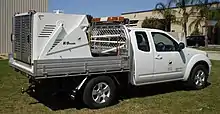
Council rangers are officers employed by local government areas in Australia to enforce the by-laws (local laws in Western Australia); of those local governments and a limited range of state laws relating to such matters as litter control, animal control, dog laws, fire control, off-road vehicles, emergency management, and parking. Unless they are also sworn in as special constables, as many are, rangers do not have full police powers. Council rangers are also referred to as local laws officers in some of Australia's eastern states. Most Council rangers have the power to issue fines that don't exceed a certain amount.
Transportation
By agreement between the various commissioners, most police cars in Australia are predominantly white, with a blue and white Sillitoe tartan checkered strip on the side these cars are general duties units. Australian highway patrol units also have fluorescent stripes surrounding the tartan, but these cars are often much more colorful and have a more complex design as pictured below . In the past, most general duties patrol cars were Holden Commodores or Ford Falcons, while Highway Patrol vehicles were often higher performance vehicles such as the Holden Commodore SS and Ford Falcon XR6. With the demise of Holden and Ford production in Australia, recent Highway Patrol livery now includes the Chrysler 300 SRT, BMW 530d,[4][5] Kia Stinger,[6] Volkswagen Passat, Mercedes-Benz E400d and Toyota Aurion. Prisoner transport vehicles are based on light commercial vehicles such as the Ford Ranger, Toyota Hilux, Holden Colorado, Mercedes Vito or Volkswagen Transporter. .
A wide range of vehicles is used for unmarked purposes to not be easily identified as police. Many of these vehicles are also specifically chosen to fit in with civilian vehicles. Emergency lights on police vehicles are now generally blue and red; historically though, blue lights were used for police vehicles and red lights for fire engines and ambulances. Council Ranger vehicles are usually fitted with either magenta or orange colored lights.
Most Australian police services have mounted police units that are prominently used for ceremonial purposes, although in New South Wales, South Australia, Western Australia and Victoria the mounted police also undertake operational policing duties.
 South Australia Police Holden ZB Commodore General Duties patrol cars
South Australia Police Holden ZB Commodore General Duties patrol cars_sedan%252C_NSW_Police_Force_(18179928673).jpg.webp) New South Wales Police Force Ford Falcon General Duties Car
New South Wales Police Force Ford Falcon General Duties Car_TX_RWD_wagon%252C_Victoria_Police_(2015-01-03).JPG.webp) A Ford Territory General Duties unit of the Victoria Police. This vehicle has now been replaced by the Toyota Kluger and Hyundai SantaFe.
A Ford Territory General Duties unit of the Victoria Police. This vehicle has now been replaced by the Toyota Kluger and Hyundai SantaFe..jpg.webp) A New South Wales Police Force BMW 5 Series Highway Patrol car
A New South Wales Police Force BMW 5 Series Highway Patrol car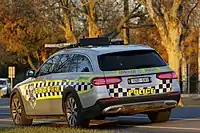 A New 2020 Victoria Police Mercedes E Class Highway Patrol car
A New 2020 Victoria Police Mercedes E Class Highway Patrol car_utility%252C_Western_Australia_Police_(2018-08-06).jpg.webp) A Holden VF Divisional Van of the Western Australia Police
A Holden VF Divisional Van of the Western Australia Police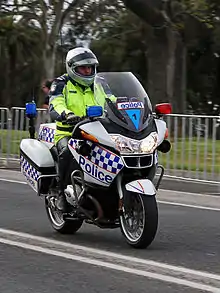 Victoria Police motorcycle
Victoria Police motorcycle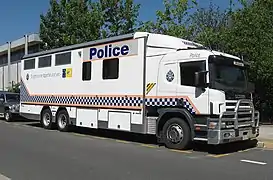 An ACT Policing Scania Mobile Command Unit
An ACT Policing Scania Mobile Command Unit.jpg.webp) A Victoria Police marine operations boat in Melbourne
A Victoria Police marine operations boat in Melbourne.jpg.webp) A New South Wales Police PolAir Eurocopter Helicopter
A New South Wales Police PolAir Eurocopter Helicopter_Pilatus_PC-12-47E_parked_at_Wagga_Wagga_Airport_(1).jpg.webp) South Australia Police Pilatus airplane
South Australia Police Pilatus airplane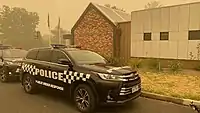 A Victoria Police Public Order Response Team Toyota Kluger Car parked at Corryong Police Station in Victoria.
A Victoria Police Public Order Response Team Toyota Kluger Car parked at Corryong Police Station in Victoria. A Queesland Police Service Remembrance Day Holdcen VF Promotional Car.
A Queesland Police Service Remembrance Day Holdcen VF Promotional Car.
See also
References
- "About ANZPAA". www.anzpaa.org.au. Retrieved 21 March 2020.
- The CrimTrac Agency. "CrimTrac". crimtrac.gov.au.
- "Office of the Sheriff of New South Wales". www.courts.justice.nsw.gov.au. Retrieved 3 January 2016.
- Andrew Chesterton (16 October 2017). "New NSW Police cars confirmed at last". MSN.
- Tim Robson (21 May 2018). "Chrysler 300 SRT and BMW 530d confirmed for NSW Police". CarsGuide.
- Dowling, Joshua (5 July 2018). "Queensland Police deploy Kia Stinger highway patrol cars". Retrieved 11 July 2018.